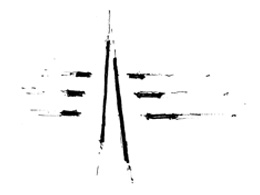STUDENTS PROJECTS
PROJECTS2013
Students: Koufidis Christos, Pittas Konstantinos
Supervisor Professor: Kourkoulas Andreas, Tsiraki Sofia
Advisor Professor: Manios Manolis
National Technical University of Athens, NTUA
Presentation date: 12 November 2014
Subject of this dissertation project is the design of a Lighthouse Museum in the most south bound of Andros Island, "Strait" as it is called, across of Dusbato lighthouse of Tinos. The intention of the current project concerns the encouragement of the network of the Greek lighthouses, which is one of the greatest internationally, being a valuable feature of the nautical cultural heritage of our country. As the time goes by and a new technological context arises, the Lighthouse turns relatively inactive as a sailing tool broadly and it is abandoned in the most outlandish and inaccessible coastlines, an industrial remnant of another epoch. Our proposal questions the relation of narration and experience in the design of the Museum space, prioritising the value of the experienced perception of place and remains in the border between building - urban installation, between protection - exposure in the site of interest and finally between land and sea. It stands in the edge of land to refer to the sea.
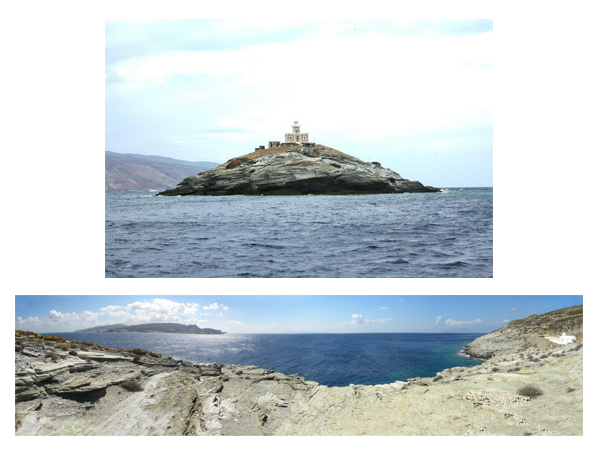
_Network, Function
Each lighthouse constitutes an equivalent point in a grid that distinguish land from sea. It has an unbelievable range, concerning the geographical position, the design, the altitude, the relation with the sea and the weather conditions. It has a unique identity (frequency of radiance), finally resulting in a code, the Lighthouse Network. The Greek Lighthouse Network counts 1500 lighthouses and lamps, 120 of which are stone - built. The unique morphology of the Greek coastline and the historically significant marine commercial exchange demanded the existence of lights in the commercial routes.
The construction of the Lighthouse is regarded as requisite in the most difficult and "marginal" sites and is governed by the principle of the minimum, which is a tower for the light and a warehouse for the supplies and the lighthouse keepers. It is a tower/landmark and at the same time just a spatial point. In the beginning, it functioned mechanically; using plumb bobs that caused rotation of the optical before we end up it the contemporary automatic function.
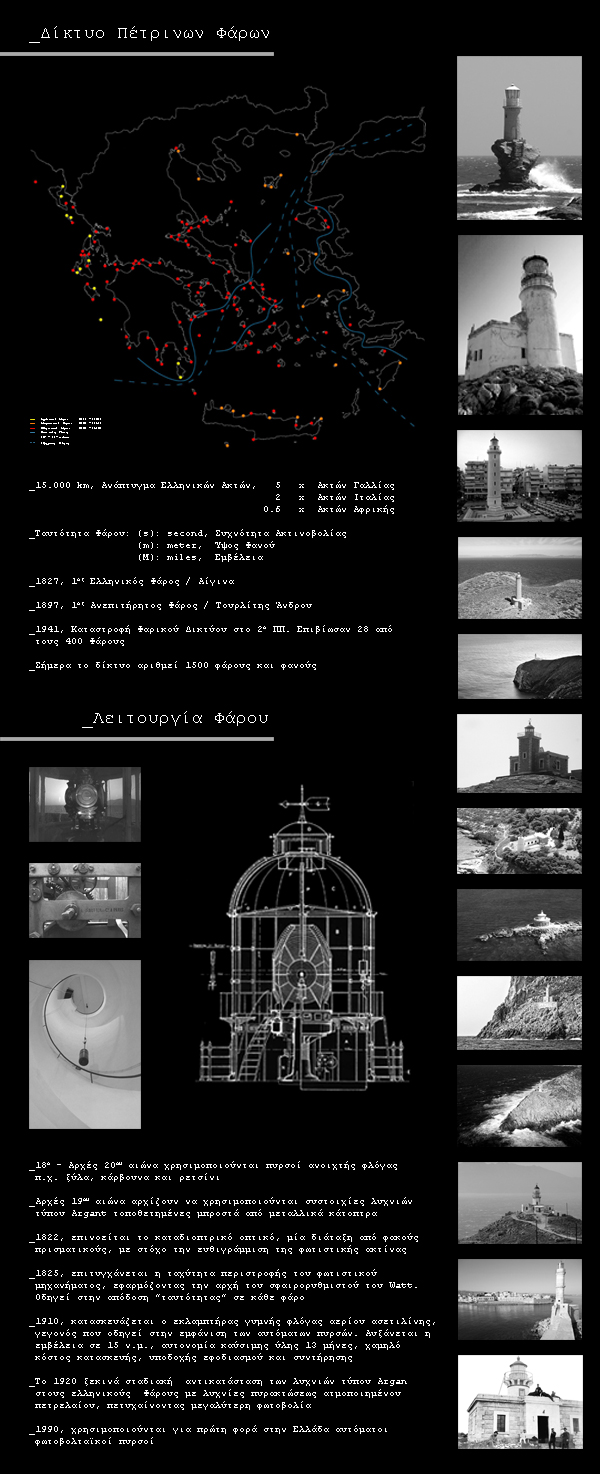
_Contemporary Condition
Nowadays, automatic metallic lights have replaced most stone - built lighthouses. The profession of the lighthouse keeper has almost disappeared and most of the structures face problems of static sufficiency. Just a few lighthouses have been restored. Nonetheless, a large number of objects of technology such as opticals, plumb bobs, drawings et al. have acquainted a historical value. They have been salvaged and are substandardly exhibited either in the Lighthouse Service office, or in the Nautical Museum of Greece.
At that point of the project, a question concerning the Museum space arises. Supposing that each lighthouse has a unique character, based on its material substance in the natural space, which should then be the aim of such a Museum for the Lighthouse Network? Could a neutral narrative representation of architecture substitute the relation of each lighthouse in the uniqueness of the natural space? Our proposal chooses to highlight the feature of the lived experience of the relation of lighthouse - place, reducing the amount of the objects of exhibition. As far as our project is concerned, the poetic of space and the interaction of lighthouse - place - time dominate.
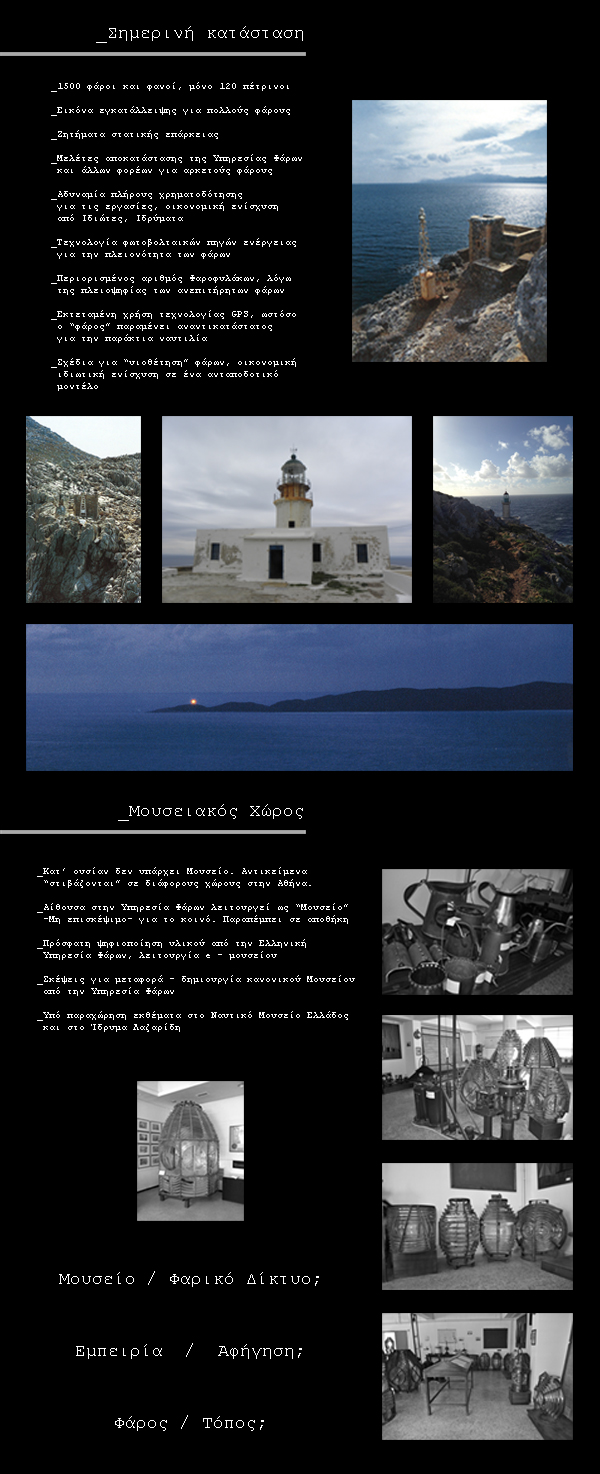
_Andros, "Dusbato Strait"
We have chosen Andros island as a site of interest, based on its position and its nautical history in the broader Cyclades complex. It counts 4 lighthouses, more that any other Greek island and it is located in the heart of the commercial routes in the middle of the lighthouses network. Moreover, the existing cultural context of the island could support our proposal. In the most South bound of Andros, across of Dusbato lighthouse of Tinos (only 800 meters) a "Gate" is set, a compulsory passage for the marine traffic.
The "Strait" edge is a rocky, barren and isolated place. Special feature of the site of interest is a very strong north wind that disturbs the marine transportation. Nevertheless, sailing boats, "caiques" and other smaller ships obligingly traverse the passage with the absolute support of the lighthouse.
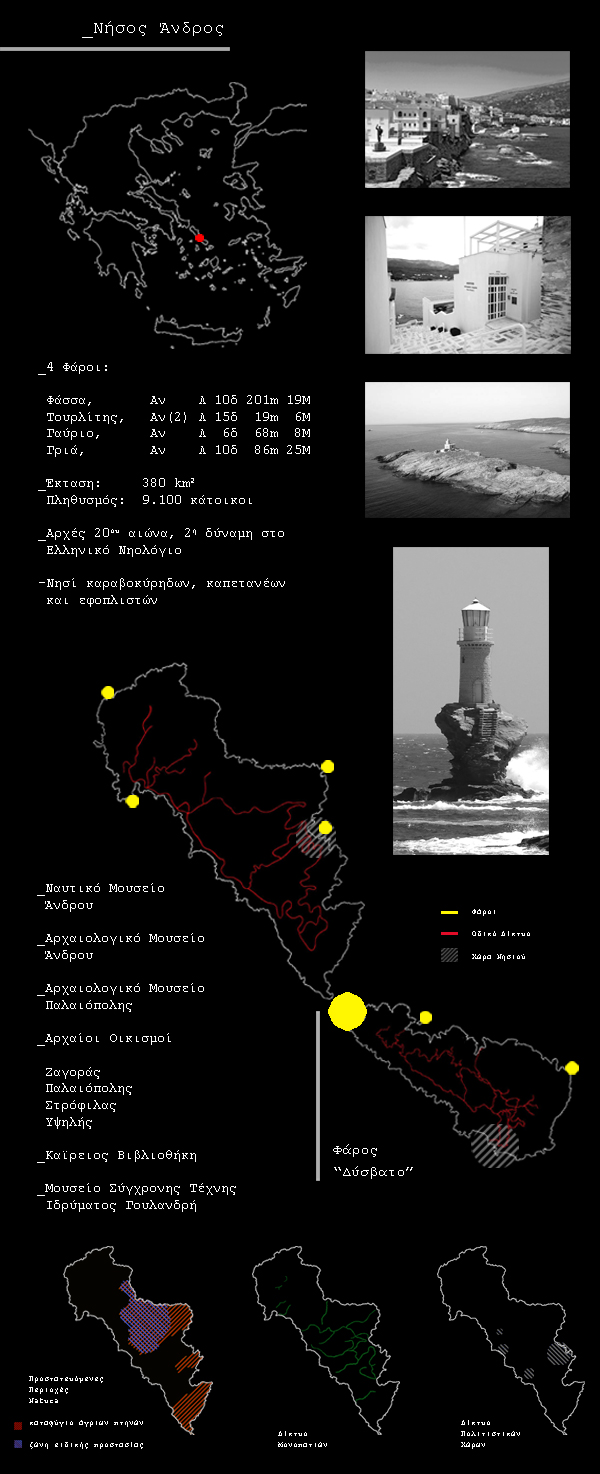
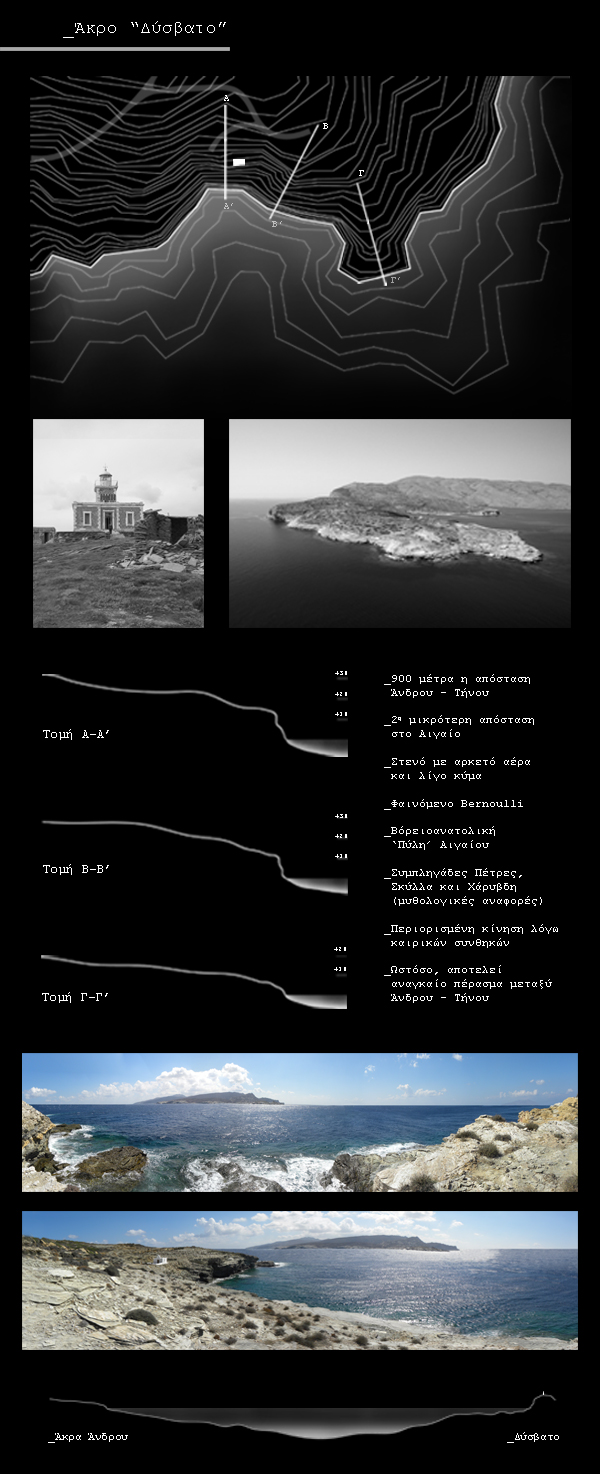
_The idea
Fundamental gesture of the design is a "section" in the rocky place, a linear gesture related to the "point" presence of the lighthouse. These two elements define and intensify the Gate. The two concrete walls "frame" the lighthouse and create the three weather conditions zones, the zone of extreme weather, the zone of protection and the lull zone. The unhindered descent to the sea and the reconciliation with the border lead to the existence of two entrances, one from the mountain and one from the sea that create two converse motions with reverse origins and terminations - climaxes. Finally, we design three sections - air "pipes" abeam that guide the strong wind inside the building.
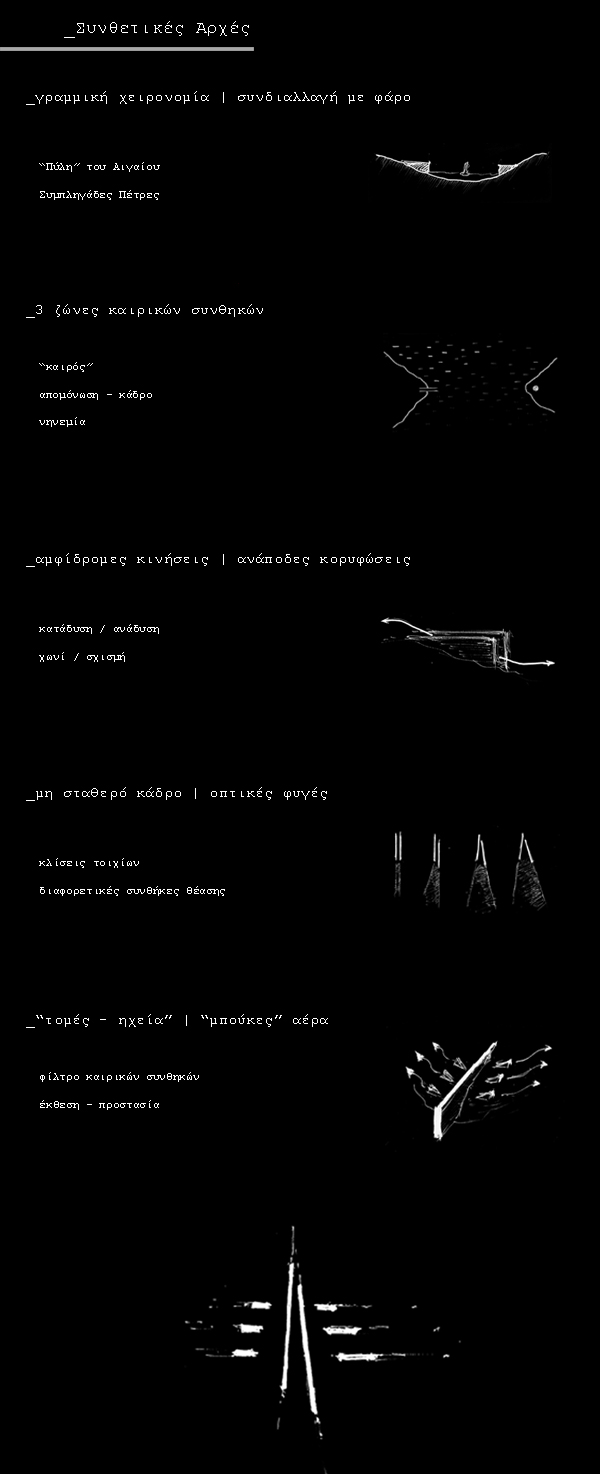
_Central Section, "Frame"
In this project the matter of framing is absolutely critical, as it is a core inherent feature of this building. As the visitor enters the concrete walls, he is isolated from the place. The concrete timbers block the gaze for a while, leading the way to the dominant staircase. After a while, the visual relation is restored in a new context. The lighthouse stands alone in front of as, in a "moving" frame, as a result of the inclination of the walls and the reversed perspective. Furthermore, the distance of the two walls, which at the end is almost limited, and the alternation between light and shadows create unique conditions concerning the ascent back in the place.

_Sections, Wind "Way - in's"
The dominant staircase that unites the two entrances is being interrupted in every level to guide the visitors in the 6 exhibiting spaces, two for each way - in. These spaces were designed within the less possible dimensions, the objects for exhibition are being reduced and the emphasis is placed in the lived experience and the reconcilement with the lighthouse and each place. The design of the exhibiting spaces was based on the manipulation of sound and light and there was an effort to create different conditions at every restricted hall and refer among others to a well (shaft), a hall for "sibilation" or water for example. Finally, it should be underlined that this project is about a non-building, a semi-outdoor creation, without typical separations of indoor and outdoor space, an ‘‘abandoned dominant skeleton'' that waits for place and time to leave their mark.



Related articles:
- DESTROY below the ACROPOLIS - VIDEO ( 13 November, 2007 )
- Architectural cannibalism in Athens ( 23 July, 2009 )
- The Acropolis Museum: An Unhappy Fit ( 08 June, 2010 )
- The New Acropolis Museum: A Triumph of Sophistry ( 21 September, 2009 )
- Αrchitectural competition ( 13 March, 2009 )
- D. Areopagitou 2008: reformation competition of the rear views of historic buildings towards the new Acropolis Museum ( 25 July, 2011 )
- New Acropolis museum ( 06 January, 2013 )
- All about fish ( 14 February, 2013 )
- New Acropolis Museum (NAM) ( 07 October, 2013 )
- The archaeological museum of Ancient Messene and the architectural configurations of the archaeological site ( 08 January, 2014 )
- Redefining Leftovers ( 05 April, 2014 )
- Theatre complex at Koukaki, Athens ( 20 January, 2014 )
- Reformation and rehabilitation of an inactive quarry, with spatial location of uses for Tourism, Recreation and Environmental Education ( 10 February, 2014 )
- Cultural center of Glyfada ( 23 February, 2014 )
- Environmental Center and Cultural Center in Kaiafa’s Lake ( 21 March, 2014 )
- The rack railway museum at Vouraikos gorge ( 18 April, 2014 )
- Museum of underwater antiquities in Chios ( 01 June, 2014 )
- Archaeological museum in Astypalaia ( 03 November, 2014 )
- Art multiplex in the Customs Office area in Palaia, Volos ( 24 February, 2015 )
- Diploma projects exhibition museum of school of architecture ( 02 March, 2015 )
- Archaeological Museum for the Neighbourhood of Plato’s Academy ( 15 April, 2015 )
- Palazzo di Lorenzo’s Museum in Sicily ( 15 May, 2015 )
- New Archaeological Museum of Delos ( 19 July, 2015 )
- Archaeological Museum of Eleftherna ( 01 September, 2015 )
